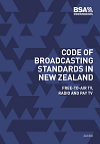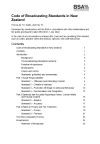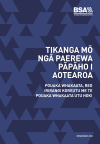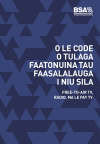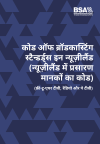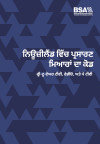Developed by broadcasters and the BSA in consultation with other stakeholders and the public and issued to take effect from 1 July 2022.
In the case of any inconsistency between this Code and any predating BSA material such as codes, practice notes, and advisory opinions, this Code will prevail.
Introduction
As we look to the future by amending the Broadcasting Codebook, we are constrained by the past.
The Code derives from the Broadcasting Act 1989, which has remained mostly unchanged for 33 years. But society has not stood still, with major changes in the environment in which the Code operates.
The internet, and the technologies it has enabled, have led to dramatic shifts in modes of communication, and to the sheer amount and variety of information and content accessible.
While there have been great benefits to society, there is also much discussion and concern about the role these changes play in the spread of misinformation and disinformation, harmful material, polarisation, impact on ‘traditional’ elements of the media sector, like broadcasting, and on democracy itself.
We are also a far more diverse society (more than 160 languages are spoken in Aotearoa New Zealand) with a resulting range of opinions and perspectives. This has been reflected in our research, which shows quite different attitudes to issues like discrimination and denigration.
It is a startlingly changed environment in which to interpret our legislation focused on ensuring broadcasters appropriately fulfil their key role in society. While there has been a lot of discussion about new approaches to content regulation, it has yet to eventuate.
It means we need to ensure, as much as our legislation allows, that the code reflects the modern context and is easy for audiences to understand. We must also do so in a way which does not unduly restrict freedom of expression – a cornerstone of robust democracies, which is protected in the New Zealand Bill of Rights Act.
We acknowledge too the principles of partnership, protection and participation in Te Tiriti o Waitangi and consider the needs, aspirations and cultural values of tangata whenua. The Authority recognises the important relationship Te Tiriti guarantees and that it has more work to do to ensure it is reflected properly in its work with tangata whenua, broadcasters and audiences.
The following Code and guidelines, while shortened and adapted in places, are true to what we have learned since 1989 but also reflect that society has moved and will continue to do so.
Background
The Broadcasting Act 1989 (the Act) creates a system of broadcasting standards. This Code provides guidance to all broadcasters (including those on radio, free-to-air television and pay television) and their audiences on the standards. Until this Code was introduced there were separate codes for each platform, and there remain important differences which are acknowledged and reflected where appropriate. There is a separate code for election programmes.
The Act enables people to complain to a broadcaster if they think standards have been breached. People who are dissatisfied with the broadcaster’s response can refer their complaint to the Broadcasting Standards Authority (BSA) for independent determination.
The Broadcasting Standards Authority
The BSA must deal with complaints fairly and without undue formality, and observe the rules of natural justice. We acknowledge the richness of New Zealand’s diverse community and try to respond to complaints appropriately in different cultural contexts, including by seeking external cultural advice and independent translations or interpretations where appropriate.
The BSA is also conscious of its role in observing and promoting New Zealand’s international commitments under, for example, the UN Declaration on the Rights of Indigenous Peoples and the UN Convention on the Rights of the Child.
Freedom of expression
New Zealand is a liberal democracy where we value the vital role of broadcasters’ content, both as an exercise of the right to freedom of expression and for the vibrant and robust exchange of information and ideas it creates. Broadcasters can hold the powerful to account, express our identity, reflect and stimulate culture. They can teach us about the world and entertain us.
However, when standards are not followed harm can result which may justify limiting the right to freedom of expression. Our co-regulatory complaints system recognises this. The law and common sense require us to be cautious before restricting freedom of expression. The New Zealand Bill of Rights states this should only occur when it is ’demonstrably justified in a free and democratic society’. The level of public interest in a broadcast is particularly important too. It can be difficult to strike a balance but it’s the Authority’s responsibility to do so in the public interest.
Broadcasters
Broadcasting standards apply to New Zealand TV and radio broadcasters of all sizes. Each broadcasting platform airs a variety of programmes to cater for the diverse languages, cultures and expectations of its audience. Te Reo and te Ao Māori have a special constitutional significance in New Zealand’s society and this is reflected in our broadcasting environment.
Choice and control
The ability for people to choose and control what they and the children and young people in their care encounter on TV or radio means the responsibility for safe viewing or listening is shared by audiences too. Broadcasters provide audiences with a number of tools for this, such as parental locks, classifications, audience advisories and timebands on free-to-air TV and appropriate scheduling and audience advisories on radio.
The level of choice and control available to an audience is a significant factor in determining what’s acceptable and whether broadcasters have met their responsibilities. In particular, pay TV operates in a less restrictive environment due to the choice customers make in paying to receive broadcasts.
Standards, Guidelines and Commentary
In the following pages we set out the eight standards that apply to TV and radio broadcasts, along with guidelines for each, and we elaborate on these in the commentary. The guidelines and commentary are just that – they are not firm rules and do not carry the same weight as the standards. The wording of each standard and its objectives are to the fore when we determine if a standard has been breached.
The guidelines and commentary will inform how each standard is interpreted. They are designed to allow flexibility in how standards are applied and interpreted as required by particular circumstances or context, including the platform on which the content was broadcast.
The Codebook Download
